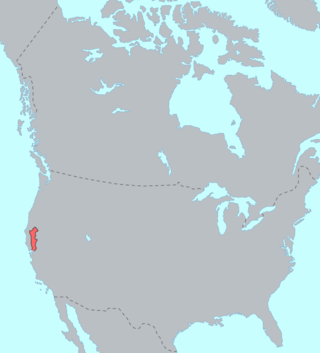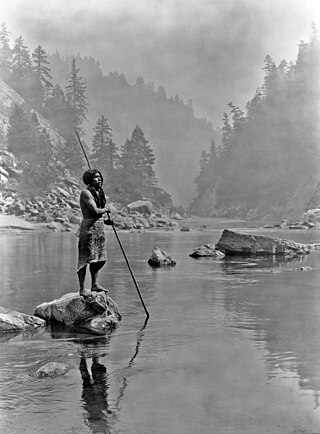Related Research Articles

The Pomo are a Native American people of California. Historical Pomo territory in Northern California was large, bordered by the Pacific Coast to the west, extending inland to Clear Lake, mainly between Cleone and Duncans Point. One small group, the Tceefoka, lived in the vicinity of present-day Stonyford, Colusa County, were they were separated from the majority of Pomo lands by Yuki and Wintuan speakers.

Athabaskan is a large family of Indigenous languages of North America, located in western North America in three areal language groups: Northern, Pacific Coast and Southern. Kari and Potter (2010:10) place the total territory of the 53 Athabaskan languages at 4,022,000 square kilometres (1,553,000 sq mi).

The Wintun are members of several related Native American peoples of Northern California, including the Wintu (northern), Nomlaki (central), and Patwin (southern). Their range is from approximately present-day Lake Shasta to San Francisco Bay, along the western side of the Sacramento River to the Coast Range. Each of these tribes speak one of the Wintuan languages. Linguistic and archaeological evidence suggests that the Wintun people probably entered the California area around 500 AD from what is now southern Oregon, introducing bow and arrow technology to the region. There has been carbon dating of several artifacts by UC Berkeley that dates back to around 10,000 years, and several of these artifacts have now been repatriated. Despite being a major influence on the region's history, there is still very little history on the Wintu due to centuries of genocide and displacement that still occur today along with continued destruction of sacred ceremonial and religious sites, often due to companies that ignore legal or ethical considerations.

Hupa are a Native American people of the Athabaskan-speaking ethnolinguistic group in northwestern California. Their endonym is Natinixwe, also spelled Natinook-wa, meaning "People of the Place Where the Trails Return". The Karuk name was Kishákeevar / Kishakeevra. The majority of the tribe is enrolled in the federally recognized Hoopa Valley Tribe.

The Pomoan, or Pomo, languages are a small family of seven languages indigenous to northern California spoken by the Pomo people, whose ancestors lived in the valley of the Russian River and the Clear Lake basin. Four languages are extinct, and all surviving languages except Kashaya have fewer than ten speakers.

Wintuan is a family of languages spoken in the Sacramento Valley of central Northern California.

The Cahto are an Indigenous Californian group of Native Americans. Today most descendants are enrolled as the federally recognized tribe, the Cahto Indian Tribe of the Laytonville Rancheria, and a small group of Cahto are enrolled in the Round Valley Indian Tribes of the Round Valley Reservation.

Hupa is an Athabaskan language spoken along the lower course of the Trinity River in Northwestern California by the Hoopa Valley Hupa and Tsnungwe/South Fork Hupa and, before European contact, by the Chilula and Whilkut peoples, to the west.

The Yuki–Wappo or Yukian languages are a small language family of western California consisting of two distantly related languages, both now extinct.
The Tolowa language is a member of the Pacific Coast subgroup of the Athabaskan language family. Together with three other closely related languages it forms a distinctive Oregon Athabaskan cluster within the subgroup.
Eel River Athapaskan traditional narratives include myths, legends, tales, and oral histories.
Hupa traditional narratives include myths, legends, tales, and oral histories preserved by the Hupa, Chilula, and Whilkut people of the Trinity River basin and vicinity of northwestern California. The Hupa people of modern times number in the several thousands and live in the Hoopa Valley located in Humboldt County, California.
Kato traditional narratives include myths, legends, tales, and oral histories preserved by the Kato (Cahto) people of the Eel River basin of northwestern California.
Pliny Earle Goddard was an American linguist and ethnologist noted for his extensive documentation of the languages and cultures of the Athabaskan peoples of western North America. His early research, carried out under the auspices of the University of California, Berkeley, focused on the Hupa and adjacent Athabaskan groups in northwestern California. After moving to New York in 1909 at the invitation of Franz Boas his scope expanded to include the Athabaskans of the Southwest, Canada, and Alaska. During the 1910s and 1920s. as Boas's junior colleague at the American Museum of Natural History and Columbia University, Goddard played a major role in creating the academic infrastructure for American Indian linguistics and anthropology in North America.

Mattole, or Mattole–Bear River, is an extinct Athabaskan language once spoken by the Mattole and Bear River peoples of northern California. It is one of the four languages belonging to the California Athabaskan cluster of the Pacific Coast Athabaskan languages. It was found in two locations: in the valley of the Mattole River, immediately south of Cape Mendocino on the coast of northwest California, and a distinct dialect on Bear River, about 10 miles to the north.
Upper Umpqua is an extinct Athabaskan language formerly spoken along the south fork of the Umpqua River in west-central Oregon by Upper Umpqua (Etnemitane) people in the vicinity of modern Roseburg. It has been extinct for at least fifty years and little is known about it other than it belongs to the same Oregon Athabaskan cluster of Pacific Coast Athabaskan languages as the Lower Rogue River language, Upper Rogue River language and Chetco-Tolowa.
Patwin (Patween) is a critically endangered Wintuan language of Northern California. As of 2021, there was one documented first language speaker of Patwin. As of 2010, Patwin language classes were taught at the Yocha Dehe Wintun Nation tribal school.

Southern Athabaskan is a subfamily of Athabaskan languages spoken primarily in the Southwestern United States with two outliers in Oklahoma and Texas. The languages are spoken in the northern Mexican states of Sonora, Chihuahua, Coahuila and to a much lesser degree in Durango and Nuevo León. Those languages are spoken by various groups of Apache and Navajo peoples. Elsewhere, Athabaskan is spoken by many indigenous groups of peoples in Alaska, Canada, Oregon and northern California.
Proto-Athabaskan is the reconstructed ancestor of the Athabaskan languages.
Victor Golla (1939–2021) was a linguist and a leading expert on the indigenous languages of California and Oregon, especially the Pacific Coast Athabaskan subgroup of the Athabaskan language family and the languages of the region that belong to the Penutian phylum. He was emeritus professor of anthropology at Humboldt State University and lived in Trinidad, California.
References
- ↑ Golla, Victor (2011). California Indian languages. Berkeley: University of California Press. ISBN 978-0-520-26667-4. OCLC 668191602.
- Goddard, Pliny Earle; Bill Ray (1909). Kato texts. The University Press. Retrieved 24 August 2012. University of California Publications in American Archaeology and Ethnography 5(3):65-238.
- Goddard, Pliny Earle (1912). Elements of the Kato Language. University of California Publications in American Archaeology and Ethnography 11(1):1-176.
- Goddard, Pliny Earle (1916). Elements of the Kato language. University of California Press. Retrieved 24 August 2012.
- Golla, Victor (2011). California Indian Languages. Berkeley: University of California Press. ISBN 978-052-026667-4.